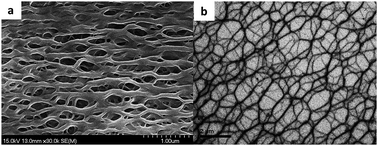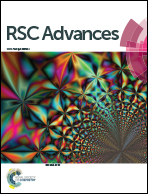High transparency and toughness PMMA nanocomposites toughened by self-assembled 3D loofah-like gel networks: fabrication, mechanism, and insight into the in situ polymerization process
Abstract
Novel types of transparent PMMA composites were toughened with 3D loofah-like gel networks obtained via the in situ polymerization of methyl methacrylate (MMA) gel with POSS-based supramolecular POSS-Lys(BOC) gelators that have excellent compatibility with the polymerized matrix for the nanoscale nature of supramolecular gel fibers. The “gel networks-energy dissipation” toughening mechanism was investigated using SEM, tensile testing and DMA, the results of which demonstrate that a favorable architecture formed by the gel nanofibres through hydrogen bonding interactions contributes to the toughness improvement in these nanocomposites. In particular, UV-Vis spectrometry and haze meter tests indicate that the PMMA nanocomposites maintain the advantage of good optical transparency. In addition, the physical self-assembly nature of the gel networks allows them to be easily extracted from the polymer matrix, the result of which clearly demonstrates the framework formed by the nanofibres has not only been retained during the in situ polymerization process, but also has an outstanding capacity for the dissipation of energy. As a result, a special type of nanoporous materials with stable pore shapes was obtained, which has potential applications in optical sensors, energy storage and as a Li-ion battery separator.


 Please wait while we load your content...
Please wait while we load your content...